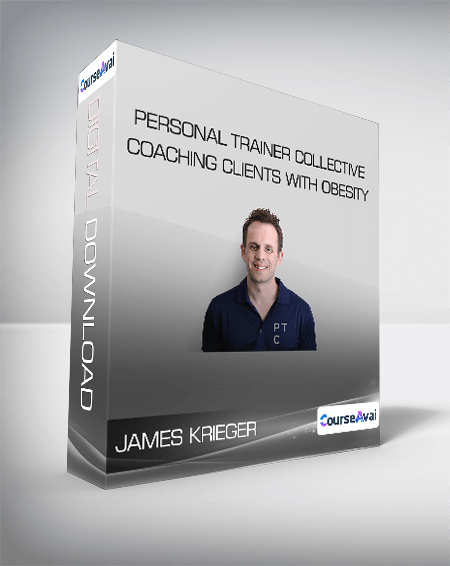James Krieger – Personal Trainer Collective – Coaching Clients with Obesity
Original price was: $431.00.$54.90Current price is: $54.90.
Coaching Clients with Obesity is specifically designed to empower the personal trainer when dealing with the unique challenges of clients with obesity. Obesity is a global epidemic, and clients with obesity need special consideration from both a nutritional and exercise standpoint.
Description
Unlock your potential with the Unlock your potential with the James Krieger - Personal Trainer Collective - Coaching Clients with ObesityJames Krieger - Personal Trainer Collective - Coaching Clients with Obesity course for only course for only Original price was: $431.00.Original price was: $431.00.$$54.9054.90Current price is: $54.90.Current price is: $54.90. at at Giolib.comGiolib.com! Explore our comprehensive library of over 60,000 downloadable digital courses across various ! Explore our comprehensive library of over 60,000 downloadable digital courses across various Sports & FitnessSports & Fitness. Get expert-led, self-paced learning at up to 80% savings. Elevate your skills today!. Get expert-led, self-paced learning at up to 80% savings. Elevate your skills today!
 James Krieger – Personal Trainer Collective – Coaching Clients with Obesity
James Krieger – Personal Trainer Collective – Coaching Clients with Obesity
What will James teach you?What will James teach you?
Coaching Clients with Obesity is specifically designed to empower the personal trainer when dealing with the unique challenges of clients with obesity. Obesity is a global epidemic, and clients with obesity need special consideration from both a nutritional and exercise standpoint.Coaching Clients with Obesity is specifically designed to empower the personal trainer when dealing with the unique challenges of clients with obesity. Obesity is a global epidemic, and clients with obesity need special consideration from both a nutritional and exercise standpoint.
Course Syllabus
Course Syllabus
What will James teach you?What will James teach you?
Coaching Clients with Obesity is specifically designed to empower the personal trainer when dealing with the unique challenges of clients with obesity. Obesity is a global epidemic, and clients with obesity need special consideration from both a nutritional and exercise standpoint.Coaching Clients with Obesity is specifically designed to empower the personal trainer when dealing with the unique challenges of clients with obesity. Obesity is a global epidemic, and clients with obesity need special consideration from both a nutritional and exercise standpoint.
Course Syllabus
Course Syllabus
Module 1: Obesity – A Unique ChallengeModule 1: Obesity – A Unique Challenge
Unit 1: What is Obesity
Unit 1: What is Obesity
Define obesity
Define obesity
Understand the health implications of obesity
Understand the health implications of obesity
Identify the countries with the highest and lowest obesity rates
Identify the countries with the highest and lowest obesity rates
Understand the spread of obesity in the United States of America
Understand the spread of obesity in the United States of America
6 mins
6 mins
1-40
1-40
Unit 2: The Primary Driver Behind Obesity
Unit 2: The Primary Driver Behind Obesity
Understand energy balance and how it impacts body weight
Understand energy balance and how it impacts body weight
Identify the components of energy balance that are driving obesity
Identify the components of energy balance that are driving obesity
Understand how the environment can impact food intake
Understand how the environment can impact food intake
Understand how palatability and energy density can impact food intake and food-seeking behaviours
Understand how palatability and energy density can impact food intake and food-seeking behaviours
Understand optimal foraging theory and how it relates to overeating
Understand optimal foraging theory and how it relates to overeating
To identify how food technology has impacted the reinforcing characteristics of food
To identify how food technology has impacted the reinforcing characteristics of food
Define “settling point” and understand how palatability and reward impact it
Define “settling point” and understand how palatability and reward impact it
Understand how food variety impacts calorie intake
Understand how food variety impacts calorie intake
53 mins
53 mins
41-81
41-81
Unit 3: Secondary Drivers of Obesity
Unit 3: Secondary Drivers of Obesity
Identify secondary factors that are contributing to the obesity epidemic
Identify secondary factors that are contributing to the obesity epidemic
Understand how food form can impact appetite and satiety
Understand how food form can impact appetite and satiety
Understand the mechanisms via which sleep loss can contribute to obesity
Understand the mechanisms via which sleep loss can contribute to obesity
Understand how inactivity can impact food intake
Understand how inactivity can impact food intake
14 mins
14 mins
82-92
82-92
Module 2: Nutrition Strategies for Weight Management
Module 2: Nutrition Strategies for Weight Management
Unit 4: Energy Balance and Setting Calorie Targets
Unit 4: Energy Balance and Setting Calorie Targets
Understand the adaptations that occur in the body during an energy deficit
Understand the adaptations that occur in the body during an energy deficit
Identify the advantages and disadvantages of small and large energy deficits
Identify the advantages and disadvantages of small and large energy deficits
Be able to calculate calorie targets for weight loss
Be able to calculate calorie targets for weight loss
23 mins
23 mins
93-111
93-111
Unit 5: Setting up a Sustainable Nutrition Plan
Unit 5: Setting up a Sustainable Nutrition Plan
Identify the characteristics of a sustainable, reduced calorie diet
Identify the characteristics of a sustainable, reduced calorie diet
Understand appropriate protein intakes for the obese client
Understand appropriate protein intakes for the obese client
Define energy density and understand how to apply our knowledge of energy density to construct a high-satiety diet
Define energy density and understand how to apply our knowledge of energy density to construct a high-satiety diet
Understand the basic mechanisms behind the efficacy of popular diets
Understand the basic mechanisms behind the efficacy of popular diets
Understand basic semi-quantitative and non-quantitative dieting strategies
Understand basic semi-quantitative and non-quantitative dieting strategies
Understand the importance of dietary adherence
Understand the importance of dietary adherence
Identify how to alter food environment to enhance adherence
Identify how to alter food environment to enhance adherence
43 mins
43 mins
112-142
112-142
Module 3: Exercise and the Obese Client
Module 3: Exercise and the Obese Client
Unit 6: Components of Energy Expenditure
Unit 6: Components of Energy Expenditure
Identify the components of energy expenditure
Identify the components of energy expenditure
Understand the relationship between metabolism and bodyweight change
Understand the relationship between metabolism and bodyweight change
12 mins
12 mins
143-153
143-153
Unit 7: Non-Exercise Activity Thermogenesis (NEAT)
Unit 7: Non-Exercise Activity Thermogenesis (NEAT)
Define non-exercise activity thermogenesis (NEAT)
Define non-exercise activity thermogenesis (NEAT)
Understand the magnitude of inter-individual variances in NEAT
Understand the magnitude of inter-individual variances in NEAT
Understand what happens to NEAT with age, weight loss, exercise, and obesity
Understand what happens to NEAT with age, weight loss, exercise, and obesity
25 mins
25 mins
154-177
154-177
Unit 8: Impacts of Endurance Exercise and Interval Training on Energy Expenditure Fat Loss
Unit 8: Impacts of Endurance Exercise and Interval Training on Energy Expenditure Fat Loss
Understand how endurance exercise impacts energy expenditure during exercise and during recovery
Understand how endurance exercise impacts energy expenditure during exercise and during recovery
Understand how interval training impacts energy expenditure during exercise and during recovery
Understand how interval training impacts energy expenditure during exercise and during recovery
Understand how interval training compares to endurance training for energy expenditure and fat loss
Understand how interval training compares to endurance training for energy expenditure and fat loss
10 mins
10 mins
176-196
176-196
Unit 9: Impacts of Resistance Exercise on Energy Expenditure and Fat Loss
Unit 9: Impacts of Resistance Exercise on Energy Expenditure and Fat Loss
Understand how resistance training impacts energy expenditure during exercise and during recovery
Understand how resistance training impacts energy expenditure during exercise and during recovery
Understand how volume and intensity can impact energy expenditure and fat loss
Understand how volume and intensity can impact energy expenditure and fat loss
Understand how resistance exercise compares to aerobic exercise regarding the effects on metabolism and 24-hour energy expenditure
Understand how resistance exercise compares to aerobic exercise regarding the effects on metabolism and 24-hour energy expenditure
18 mins
18 mins
197-217
197-217
Unit 10: Impacts of Exercise on Abdominal Fat & FFM Retention
Unit 10: Impacts of Exercise on Abdominal Fat & FFM Retention
Understand how exercise intensity may impact abdominal fat
Understand how exercise intensity may impact abdominal fat
Understand how exercise may impact fat-free mass retention during weight loss
Understand how exercise may impact fat-free mass retention during weight loss
Identify the difference between fat-free mass and muscle
Identify the difference between fat-free mass and muscle
Understand the interaction between resistance training and fat-free-mass retention
Understand the interaction between resistance training and fat-free-mass retention
14 mins
14 mins
218-227
218-227
Unit 11: Impact of Exercise on Appetite
Unit 11: Impact of Exercise on Appetite
Understand the different appetite responses to calorie restriction and exercise
Understand the different appetite responses to calorie restriction and exercise
Identify how exercise may impact appetite
Identify how exercise may impact appetite
Understand how exercise intensity may impact appetite
Understand how exercise intensity may impact appetite
15 mins
15 mins
228-243
228-243
Unit 12: Impacts of Fasted vs Fed Exercise on Energy Expenditure and Fat Loss
Unit 12: Impacts of Fasted vs Fed Exercise on Energy Expenditure and Fat Loss
Identify the proposed mechanisms for fasted exercise improving fat loss
Identify the proposed mechanisms for fasted exercise improving fat loss
Understand the research findings regarding fasted versus fed exercise
Understand the research findings regarding fasted versus fed exercise
7 mins
7 mins
244-255
244-255
Unit 13: Exercise Training Modalities for Obese Clients
Unit 13: Exercise Training Modalities for Obese Clients
Understand the unique challenges when programming exercise for an obese client
Understand the unique challenges when programming exercise for an obese client
Identify which modalities of aerobic training, interval training, and resistance training may be most appropriate for obese clients
Identify which modalities of aerobic training, interval training, and resistance training may be most appropriate for obese clients
Apply programming principles to hypothetical examples of obese clients
Apply programming principles to hypothetical examples of obese clients
8 mins
8 mins
256-267
256-267
Unit 14: Strategies for Increasing NEAT
Unit 14: Strategies for Increasing NEAT
Identify strategies to help increase NEAT and how to incorporate them into a client’s lifestyle
Identify strategies to help increase NEAT and how to incorporate them into a client’s lifestyle
Understand how to use activity tracking devices to help increase a client’s NEAT
Understand how to use activity tracking devices to help increase a client’s NEAT
12 mins
12 mins
268-276
268-276
Module 4: Lifestyle Factors for Obesity
Module 4: Lifestyle Factors for Obesity
Unit 15: Sleep & Self Monitoring
Unit 15: Sleep & Self Monitoring
Understand strategies to enhance sleep quality and quantity
Understand strategies to enhance sleep quality and quantity
Understand the relationship between self-monitoring and success
Understand the relationship between self-monitoring and success
Identify how self-monitoring tools can be used to enhance success rates
Identify how self-monitoring tools can be used to enhance success rates
Get Get James Krieger – Personal Trainer Collective – Coaching Clients with Obesit download
277-287
277-287
Module 5: The Bigger Picture – Adherence and Long-Term Success
Module 5: The Bigger Picture – Adherence and Long-Term Success
Unit 16: Long-term Weight Maintenance
Unit 16: Long-term Weight Maintenance
Identify the reasons why long-term weight maintenance success rates are low
Identify the reasons why long-term weight maintenance success rates are low
Understand the characteristics of successful long-term weight maintainers
Understand the characteristics of successful long-term weight maintainers
Understand the importance of physical activity to long-term weight maintenance
Understand the importance of physical activity to long-term weight maintenance
15 mins
15 mins
288-296
288-296
Unit 17: Psychology of Obesity – Strategies for Adherence and Successful Weight Loss/Maintenance
Unit 17: Psychology of Obesity – Strategies for Adherence and Successful Weight Loss/Maintenance
Identify the psychological consequences and comorbidities of obesity
Identify the psychological consequences and comorbidities of obesity
Understand strategies to set a client up for success
Understand strategies to set a client up for success
Understand variables associated with successful adherence, weight loss, and weight maintenance
Understand variables associated with successful adherence, weight loss, and weight maintenance
Understand variables associated with lapses in adherence, and how to create strategies to limit lapses
Understand variables associated with lapses in adherence, and how to create strategies to limit lapses
Understand how motivation, intention, and planning are related to behavior
Understand how motivation, intention, and planning are related to behavior
Understand the advantages of flexible versus rigid approaches
Understand the advantages of flexible versus rigid approaches
Understand potential sources of tension during weight maintenance, and how to manage or resolve that tension
Understand potential sources of tension during weight maintenance, and how to manage or resolve that tension
55 mins
55 mins
297-319
297-319
Module 6: Consultation and Practical Programming
Module 6: Consultation and Practical Programming
Unit 18: Consulting with an Obese Client and Practical Application
Unit 18: Consulting with an Obese Client and Practical Application
Identify the phases of consulting an obese client
Identify the phases of consulting an obese client
Identify the information you need to gather during each consultation phase
Identify the information you need to gather during each consultation phase
Understand the basics of programming for an obese client
Understand the basics of programming for an obese client
Understand how to use this information to make adjustments based on progress
Understand how to use this information to make adjustments based on progress
Understand the special factors you need to consider when working with obese clients compared to the general population
Understand the special factors you need to consider when working with obese clients compared to the general population
47 mins
47 mins
320-357
320-357
Unit 19: Summary
Unit 19: Summary
6 mins
6 mins
358-365
358-365
About James KriegerAbout James Krieger
Published scientist, author, and founder of Weightology James Krieger has over 20 years’ combined experience of teaching, working with clients and disseminating evidence-based fitness on a global scale. James teaches Coaching Clients with Obesity for the PTC.Published scientist, author, and founder of Weightology James Krieger has over 20 years’ combined experience of teaching, working with clients and disseminating evidence-based fitness on a global scale. James teaches Coaching Clients with Obesity for the PTC.
James’ QualificationsJames’ Qualifications
M.S. Nutrition, M.S. Exercise Science, B.S. Kinesiology (Exercise Science). Published over 500 articles and more than 20 peer-reviewed scientific studies.
M.S. Nutrition, M.S. Exercise Science, B.S. Kinesiology (Exercise Science). Published over 500 articles and more than 20 peer-reviewed scientific studies.
Coaching Clients with Obesity
Coaching Clients with Obesity
FAQs
FAQs
Is this course all online?Is this course all online?
Yes – this course and all assessments associated with this course are online.Yes – this course and all assessments associated with this course are online.
How is this course assessed?
How is this course assessed?
This course is assessed via online multiple choice assessments which are found in the student portal.This course is assessed via online multiple choice assessments which are found in the student portal.
Can I do the course at my own pace?
Can I do the course at my own pace?
You can – however, you must complete all units in order. Each unit of the course has a quiz, which you must complete before progressing onto the next unit.You can – however, you must complete all units in order. Each unit of the course has a quiz, which you must complete before progressing onto the next unit.
Do I have access to the content for life?
Do I have access to the content for life?
Yes. This is something we have always promised our students, and that doesn’t change.Yes. This is something we have always promised our students, and that doesn’t change.
How much time will I need to dedicate to studying?
How much time will I need to dedicate to studying?
This course consists of 8 Guided Learning Hours. You may find you need more or less study based on your current knowledge and experience.This course consists of 8 Guided Learning Hours. You may find you need more or less study based on your current knowledge and experience.
Is this course accredited?
Is this course accredited?
Our courses are not currently accredited or associated with CPD pointsOur courses are not currently accredited or associated with CPD points
Do I get a certificate?
Do I get a certificate?
Yes – on completion, you will receive a virtual certificate detailing your results. We also send out physical certificates once per quarter to students who have registered their postal address with us.Yes – on completion, you will receive a virtual certificate detailing your results. We also send out physical certificates once per quarter to students who have registered their postal address with us.
What are the grade boundaries?
What are the grade boundaries?
Any course requires a score of 80% in the online assessment in order to pass. If you score 85% or above, you will achieve a “Merit” grade, and a score of 90% or above will earn you a “Distinction”.Any course requires a score of 80% in the online assessment in order to pass. If you score 85% or above, you will achieve a “Merit” grade, and a score of 90% or above will earn you a “Distinction”.
Are there any requirements to enrolling on the course?
Are there any requirements to enrolling on the course?
We don’t insist that you have any qualifications prior to enrolling on one of our courses. You will need a strong interest in the subject matter, a desire to learn, and a willingness to ask if you need extra help. You should have a good command of spoken and written English, and a strong enough internet connection to watch standard definition videos.We don’t insist that you have any qualifications prior to enrolling on one of our courses. You will need a strong interest in the subject matter, a desire to learn, and a willingness to ask if you need extra help. You should have a good command of spoken and written English, and a strong enough internet connection to watch standard definition videos.
Module 1: Obesity – A Unique ChallengeModule 1: Obesity – A Unique Challenge
Unit 1: What is Obesity
Unit 1: What is Obesity
Define obesity
Define obesity
Understand the health implications of obesity
Understand the health implications of obesity
Identify the countries with the highest and lowest obesity rates
Identify the countries with the highest and lowest obesity rates
Understand the spread of obesity in the United States of America
Understand the spread of obesity in the United States of America
6 mins
6 mins
1-40
1-40
Unit 2: The Primary Driver Behind Obesity
Unit 2: The Primary Driver Behind Obesity
Understand energy balance and how it impacts body weight
Understand energy balance and how it impacts body weight
Identify the components of energy balance that are driving obesity
Identify the components of energy balance that are driving obesity
Understand how the environment can impact food intake
Understand how the environment can impact food intake
Understand how palatability and energy density can impact food intake and food-seeking behaviours
Understand how palatability and energy density can impact food intake and food-seeking behaviours
Understand optimal foraging theory and how it relates to overeating
Understand optimal foraging theory and how it relates to overeating
To identify how food technology has impacted the reinforcing characteristics of food
To identify how food technology has impacted the reinforcing characteristics of food
Define “settling point” and understand how palatability and reward impact it
Define “settling point” and understand how palatability and reward impact it
Understand how food variety impacts calorie intake
Understand how food variety impacts calorie intake
53 mins
53 mins
41-81
41-81
Unit 3: Secondary Drivers of Obesity
Unit 3: Secondary Drivers of Obesity
Identify secondary factors that are contributing to the obesity epidemic
Identify secondary factors that are contributing to the obesity epidemic
Understand how food form can impact appetite and satiety
Understand how food form can impact appetite and satiety
Understand the mechanisms via which sleep loss can contribute to obesity
Understand the mechanisms via which sleep loss can contribute to obesity
Understand how inactivity can impact food intake
Understand how inactivity can impact food intake
14 mins
14 mins
82-92
82-92
Module 2: Nutrition Strategies for Weight Management
Module 2: Nutrition Strategies for Weight Management
Unit 4: Energy Balance and Setting Calorie Targets
Unit 4: Energy Balance and Setting Calorie Targets
Understand the adaptations that occur in the body during an energy deficit
Understand the adaptations that occur in the body during an energy deficit
Identify the advantages and disadvantages of small and large energy deficits
Identify the advantages and disadvantages of small and large energy deficits
Be able to calculate calorie targets for weight loss
Be able to calculate calorie targets for weight loss
23 mins
23 mins
93-111
93-111
Unit 5: Setting up a Sustainable Nutrition Plan
Unit 5: Setting up a Sustainable Nutrition Plan
Identify the characteristics of a sustainable, reduced calorie diet
Identify the characteristics of a sustainable, reduced calorie diet
Understand appropriate protein intakes for the obese client
Understand appropriate protein intakes for the obese client
Define energy density and understand how to apply our knowledge of energy density to construct a high-satiety diet
Define energy density and understand how to apply our knowledge of energy density to construct a high-satiety diet
Understand the basic mechanisms behind the efficacy of popular diets
Understand the basic mechanisms behind the efficacy of popular diets
Understand basic semi-quantitative and non-quantitative dieting strategies
Understand basic semi-quantitative and non-quantitative dieting strategies
Understand the importance of dietary adherence
Understand the importance of dietary adherence
Identify how to alter food environment to enhance adherence
Identify how to alter food environment to enhance adherence
43 mins
43 mins
112-142
112-142
Module 3: Exercise and the Obese Client
Module 3: Exercise and the Obese Client
Unit 6: Components of Energy Expenditure
Unit 6: Components of Energy Expenditure
Identify the components of energy expenditure
Identify the components of energy expenditure
Understand the relationship between metabolism and bodyweight change
Understand the relationship between metabolism and bodyweight change
12 mins
12 mins
143-153
143-153
Unit 7: Non-Exercise Activity Thermogenesis (NEAT)
Unit 7: Non-Exercise Activity Thermogenesis (NEAT)
Define non-exercise activity thermogenesis (NEAT)
Define non-exercise activity thermogenesis (NEAT)
Understand the magnitude of inter-individual variances in NEAT
Understand the magnitude of inter-individual variances in NEAT
Understand what happens to NEAT with age, weight loss, exercise, and obesity
Understand what happens to NEAT with age, weight loss, exercise, and obesity
25 mins
25 mins
154-177
154-177
Unit 8: Impacts of Endurance Exercise and Interval Training on Energy Expenditure Fat Loss
Unit 8: Impacts of Endurance Exercise and Interval Training on Energy Expenditure Fat Loss
Understand how endurance exercise impacts energy expenditure during exercise and during recovery
Understand how endurance exercise impacts energy expenditure during exercise and during recovery
Understand how interval training impacts energy expenditure during exercise and during recovery
Understand how interval training impacts energy expenditure during exercise and during recovery
Understand how interval training compares to endurance training for energy expenditure and fat loss
Understand how interval training compares to endurance training for energy expenditure and fat loss
10 mins
10 mins
176-196
176-196
Unit 9: Impacts of Resistance Exercise on Energy Expenditure and Fat Loss
Unit 9: Impacts of Resistance Exercise on Energy Expenditure and Fat Loss
Understand how resistance training impacts energy expenditure during exercise and during recovery
Understand how resistance training impacts energy expenditure during exercise and during recovery
Understand how volume and intensity can impact energy expenditure and fat loss
Understand how volume and intensity can impact energy expenditure and fat loss
Understand how resistance exercise compares to aerobic exercise regarding the effects on metabolism and 24-hour energy expenditure
Understand how resistance exercise compares to aerobic exercise regarding the effects on metabolism and 24-hour energy expenditure
18 mins
18 mins
197-217
197-217
Unit 10: Impacts of Exercise on Abdominal Fat & FFM Retention
Unit 10: Impacts of Exercise on Abdominal Fat & FFM Retention
Understand how exercise intensity may impact abdominal fat
Understand how exercise intensity may impact abdominal fat
Understand how exercise may impact fat-free mass retention during weight loss
Understand how exercise may impact fat-free mass retention during weight loss
Identify the difference between fat-free mass and muscle
Identify the difference between fat-free mass and muscle
Understand the interaction between resistance training and fat-free-mass retention
Understand the interaction between resistance training and fat-free-mass retention
14 mins
14 mins
218-227
218-227
Unit 11: Impact of Exercise on Appetite
Unit 11: Impact of Exercise on Appetite
Understand the different appetite responses to calorie restriction and exercise
Understand the different appetite responses to calorie restriction and exercise
Identify how exercise may impact appetite
Identify how exercise may impact appetite
Understand how exercise intensity may impact appetite
Understand how exercise intensity may impact appetite
15 mins
15 mins
228-243
228-243
Unit 12: Impacts of Fasted vs Fed Exercise on Energy Expenditure and Fat Loss
Unit 12: Impacts of Fasted vs Fed Exercise on Energy Expenditure and Fat Loss
Identify the proposed mechanisms for fasted exercise improving fat loss
Identify the proposed mechanisms for fasted exercise improving fat loss
Understand the research findings regarding fasted versus fed exercise
Understand the research findings regarding fasted versus fed exercise
7 mins
7 mins
244-255
244-255
Unit 13: Exercise Training Modalities for Obese Clients
Unit 13: Exercise Training Modalities for Obese Clients
Understand the unique challenges when programming exercise for an obese client
Understand the unique challenges when programming exercise for an obese client
Identify which modalities of aerobic training, interval training, and resistance training may be most appropriate for obese clients
Identify which modalities of aerobic training, interval training, and resistance training may be most appropriate for obese clients
Apply programming principles to hypothetical examples of obese clients
Apply programming principles to hypothetical examples of obese clients
8 mins
8 mins
256-267
256-267
Unit 14: Strategies for Increasing NEAT
Unit 14: Strategies for Increasing NEAT
Identify strategies to help increase NEAT and how to incorporate them into a client’s lifestyle
Identify strategies to help increase NEAT and how to incorporate them into a client’s lifestyle
Understand how to use activity tracking devices to help increase a client’s NEAT
Understand how to use activity tracking devices to help increase a client’s NEAT
12 mins
12 mins
268-276
268-276
Module 4: Lifestyle Factors for Obesity
Module 4: Lifestyle Factors for Obesity
Unit 15: Sleep & Self Monitoring
Unit 15: Sleep & Self Monitoring
Understand strategies to enhance sleep quality and quantity
Understand strategies to enhance sleep quality and quantity
Understand the relationship between self-monitoring and success
Understand the relationship between self-monitoring and success
Identify how self-monitoring tools can be used to enhance success rates
Identify how self-monitoring tools can be used to enhance success rates
12 mins12 mins
277-287
277-287
Module 5: The Bigger Picture – Adherence and Long-Term Success
Module 5: The Bigger Picture – Adherence and Long-Term Success
Unit 16: Long-term Weight Maintenance
Unit 16: Long-term Weight Maintenance
Identify the reasons why long-term weight maintenance success rates are low
Identify the reasons why long-term weight maintenance success rates are low
Understand the characteristics of successful long-term weight maintainers
Understand the characteristics of successful long-term weight maintainers
Understand the importance of physical activity to long-term weight maintenance
Understand the importance of physical activity to long-term weight maintenance
15 mins
15 mins
288-296
288-296
Unit 17: Psychology of Obesity – Strategies for Adherence and Successful Weight Loss/Maintenance
Unit 17: Psychology of Obesity – Strategies for Adherence and Successful Weight Loss/Maintenance
Identify the psychological consequences and comorbidities of obesity
Identify the psychological consequences and comorbidities of obesity
Understand strategies to set a client up for success
Understand strategies to set a client up for success
Understand variables associated with successful adherence, weight loss, and weight maintenance
Understand variables associated with successful adherence, weight loss, and weight maintenance
Understand variables associated with lapses in adherence, and how to create strategies to limit lapses
Understand variables associated with lapses in adherence, and how to create strategies to limit lapses
Understand how motivation, intention, and planning are related to behavior
Understand how motivation, intention, and planning are related to behavior
Understand the advantages of flexible versus rigid approaches
Understand the advantages of flexible versus rigid approaches
Understand potential sources of tension during weight maintenance, and how to manage or resolve that tension
Understand potential sources of tension during weight maintenance, and how to manage or resolve that tension
55 mins
55 mins
297-319
297-319
Module 6: Consultation and Practical Programming
Module 6: Consultation and Practical Programming
Unit 18: Consulting with an Obese Client and Practical Application
Unit 18: Consulting with an Obese Client and Practical Application
Identify the phases of consulting an obese client
Identify the phases of consulting an obese client
Identify the information you need to gather during each consultation phase
Identify the information you need to gather during each consultation phase
Understand the basics of programming for an obese client
Understand the basics of programming for an obese client
Understand how to use this information to make adjustments based on progress
Understand how to use this information to make adjustments based on progress
Understand the special factors you need to consider when working with obese clients compared to the general population
Understand the special factors you need to consider when working with obese clients compared to the general population
47 mins
47 mins
320-357
320-357
Unit 19: Summary
Unit 19: Summary
6 mins
6 mins
358-365
358-365
About James KriegerAbout James Krieger
Published scientist, author, and founder of Weightology James Krieger has over 20 years’ combined experience of teaching, working with clients and disseminating evidence-based fitness on a global scale. James teaches Coaching Clients with Obesity for the PTC.Published scientist, author, and founder of Weightology James Krieger has over 20 years’ combined experience of teaching, working with clients and disseminating evidence-based fitness on a global scale. James teaches Coaching Clients with Obesity for the PTC.
James’ QualificationsJames’ Qualifications
M.S. Nutrition, M.S. Exercise Science, B.S. Kinesiology (Exercise Science). Published over 500 articles and more than 20 peer-reviewed scientific studies.
M.S. Nutrition, M.S. Exercise Science, B.S. Kinesiology (Exercise Science). Published over 500 articles and more than 20 peer-reviewed scientific studies.
Coaching Clients with Obesity
Coaching Clients with Obesity
FAQs
FAQs
Is this course all online?Is this course all online?
Yes – this course and all assessments associated with this course are online.Yes – this course and all assessments associated with this course are online.
How is this course assessed?
How is this course assessed?
This course is assessed via online multiple choice assessments which are found in the student portal.This course is assessed via online multiple choice assessments which are found in the student portal.
Can I do the course at my own pace?
Can I do the course at my own pace?
You can – however, you must complete all units in order. Each unit of the course has a quiz, which you must complete before progressing onto the next unit.You can – however, you must complete all units in order. Each unit of the course has a quiz, which you must complete before progressing onto the next unit.
Do I have access to the content for life?
Do I have access to the content for life?
Yes. This is something we have always promised our students, and that doesn’t change.Yes. This is something we have always promised our students, and that doesn’t change.
How much time will I need to dedicate to studying?
How much time will I need to dedicate to studying?
This course consists of 8 Guided Learning Hours. You may find you need more or less study based on your current knowledge and experience.This course consists of 8 Guided Learning Hours. You may find you need more or less study based on your current knowledge and experience.
Is this course accredited?
Is this course accredited?
Our courses are not currently accredited or associated with CPD pointsOur courses are not currently accredited or associated with CPD points
Do I get a certificate?
Do I get a certificate?
Yes – on completion, you will receive a virtual certificate detailing your results. We also send out physical certificates once per quarter to students who have registered their postal address with us.Yes – on completion, you will receive a virtual certificate detailing your results. We also send out physical certificates once per quarter to students who have registered their postal address with us.
What are the grade boundaries?
What are the grade boundaries?
Any course requires a score of 80% in the online assessment in order to pass. If you score 85% or above, you will achieve a “Merit” grade, and a score of 90% or above will earn you a “Distinction”.Any course requires a score of 80% in the online assessment in order to pass. If you score 85% or above, you will achieve a “Merit” grade, and a score of 90% or above will earn you a “Distinction”.
Are there any requirements to enrolling on the course?
Are there any requirements to enrolling on the course?
We don’t insist that you have any qualifications prior to enrolling on one of our courses. You will need a strong interest in the subject matter, a desire to learn, and a willingness to ask if you need extra help. You should have a good command of spoken and written English, and a strong enough internet connection to watch standard definition videos.We don’t insist that you have any qualifications prior to enrolling on one of our courses. You will need a strong interest in the subject matter, a desire to learn, and a willingness to ask if you need extra help. You should have a good command of spoken and written English, and a strong enough internet connection to watch standard definition videos.
Future-proof your knowledge with the Future-proof your knowledge with the James Krieger - Personal Trainer Collective - Coaching Clients with ObesityJames Krieger - Personal Trainer Collective - Coaching Clients with Obesity course at course at GiOlibGiOlib! Enjoy lifetime access to high-quality digital content, crafted to advance your career and personal development.! Enjoy lifetime access to high-quality digital content, crafted to advance your career and personal development.
- Lifetime Access:Lifetime Access: Permanent access to all purchased courses. Permanent access to all purchased courses.
- Smart Savings:Smart Savings: Benefit from prices up to 80% off original course costs. Benefit from prices up to 80% off original course costs.
- Safe Transactions:Safe Transactions: Process your payments securely. Process your payments securely.
- Practical Insights:Practical Insights: Gain actionable skills relevant to today's demands. Gain actionable skills relevant to today's demands.
- Instant Availability:Instant Availability: Begin your course immediately after payment. Begin your course immediately after payment.
- Flexible Learning:Flexible Learning: Access content effortlessly on any device. Access content effortlessly on any device.
Start expanding your horizons with Start expanding your horizons with GiOlibGiOlib!!





